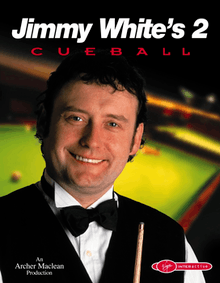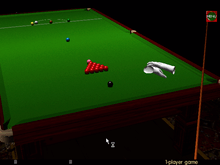Jimmy White's 2: Cueball
| Jimmy White's 2: Cueball | |
|---|---|
 | |
| Developer(s) |
Awesome Developments Vicarious Visions (Game Boy Color) |
| Publisher(s) |
Virgin Interactive Vatical Entertainment (Game Boy Color) |
| Designer(s) | Archer MacLean |
| Composer(s) | Allister Brimble (PC and Dreamcast)[1] |
| Platform(s) | Microsoft Windows, Dreamcast, PlayStation, Game Boy Color |
| Release |
Windows
|
| Genre(s) | Sports simulation – snooker and pool |
| Mode(s) | Single-player, multiplayer |
Jimmy White's 2: Cueball is a snooker and pool simulation video game published by Virgin Interactive as a sequel to Jimmy White's 'Whirlwind' Snooker. It was originally released in 1999 exclusively in Europe for Windows, and later that year for the Dreamcast, also exclusive to Europe. A PlayStation version was released in March 2000 in Europe and then in November 2000 in North America, distributed and released by Bay Area Multimedia. Archer MacLean, the designer of the original game, led the development team. The game also includes many other mini-games connected with a pub setting.
A Game Boy Color version of the game was later released in 2000. A sequel to Cueball, called Jimmy White's Cueball World, was released exclusively in Europe for the PC in 2001.
The game received mixed reviews from critics, with the PC and Dreamcast versions faring better than the PlayStation port.
Gameplay
Gameplay is derived from a pool hall located in a house. Players can move between the main hallway, the snooker room, and the pool room.[2] The player can also leave the game they were playing, and walk around the room, and begin other games without ending the earlier game they were playing.[3] Cueball features a "BeeCam" option, which can be activated at any time. It follows an animated bee flying around the rooms serving as a cutscene to view the entire room. In the two games rooms, it has multiple routes.[3]
Depending on the system, Jimmy White's 2: Cueball can be controlled by either a controller, or keyboard and mouse.[3] The player can also explore the in-game world, referred to as "Jimmy White's House", which the in-game manual describes as "a mock-up of the kind of house Jimmy White probably lives in."[3]
Improvements
A number of features from Whirlwind Snooker were improved upon for Cueball, most notably the graphical engine.[4] The game uses a 3D accelerator card enabling the player to peruse not only the table, but the entire snooker or pool room.[5] The shadows and reflections of the balls are rendered in much more detail, as are the cushions and pockets. The computer player (now represented by a pair of disembodied hands in white gloves) can be viewed from any angle while taking a shot; these hands also visibly replace the coloured and cue ball once potted.[6]

Features
Numerous items within the snooker and pool rooms are interactive. Some of them, such as the dartboard and draughts table, are mini-games.[7] An arcade machine in the pool room features a fully playable version of Dropzone, one of Archer MacLean's earliest games.[8] The pool room is a bar / diner featuring a jukebox and fruit machine. The game also has a full classical soundtrack that can be controlled by the jukebox.[4]
The game, like its predecessor, features humorous elements. Should the computer player lay a particularly nasty snooker, an evil laugh is heard. Taking too long over a shot will send the computer player into a fit of sarcastic coughing.[9] A soundbite of Homer Simpson exclaiming "D'oh!" is also heard when a player pockets the cue-ball.[10] However, unlike Jimmy White's 'Whirlwind' Snooker, the game does not have any visual gags; as the comedy is contained to the audio.
Development
A small team known as Awesome Developments, (which would later become UTV Ignition Games), began developing Cueball in 1997. The game was originally made to be promoted by a different publisher, however, they wanted an association football game, rather than one designed around snooker. This publisher would later be assimilated into Electronic Arts. Virgin Interactive became the project's next publisher with a Game Boy Color version of the game published by Vatical Entertainment, and developed by Vicarious Visions.[11]
With the PC version of the game reaching over 300 megabytes, Vicarious Visions team created a two-dimensional GBC demo for the game with a much smaller size. Awesome Development's lead, Archer MacLean, commented that he had received an email regarding the GBC's game: "We've run out of sprites on the Game Boy. Do you think anyone in Englandshire will know if the Snooker game is played with only 9 reds??" The game was later released a year after the PC release, along with other console ports of the game.[11]
Reception
| Reception | ||||||||||||||||||||
|---|---|---|---|---|---|---|---|---|---|---|---|---|---|---|---|---|---|---|---|---|
| ||||||||||||||||||||
Jimmy White's 2: Cueball received mixed reviews from critics, with the PC and Dreamcast versions faring better than the PlayStation port. IGN gave the PlayStation version a 2.5/10;[15] calling the game "painful", saying the game "lost a lot in its transition to the PlayStation", while revealing "the PC version received good reviews in Europe". PSX Nation were less scathing, scoring the PlayStation game at 66/100, with the reviewer enjoying the tunes and mini-games.[16]
Whilst reviewing the Dreamcast version of the game Eurogamer called it "a highly polished and playable snooker and pool simulator."[4] The reviewer did prefer the pool simulation over the snooker, which the game is published under, noting "we all had a blast with the pool mode, although we found the Snooker a little too tricky for casual play."[4] Now Gamer! was more critical of the Dreamcast version, calling the game "far from fun and enjoyable to play."[5] They did comment on the soundtrack saying "the music is equally classical and fitting for the location."[5]
Reviewing the Dreamcast version, Computer and Video Games magazine scored the game 3 out of 5, saying "as Snooker games go, this is the best you'll find."[18] They also satirically commented "all the fun of Pool, without the bar fight."[18] UK Magazine Dreamcast Monthly rated the game at "80%",[19] saying "in short this is an excellent game, and if Snooker or Pool is your thing and you're after the ultimate simulation, then this is it."[19] They finished saying, "it's hardly cutting edge entertainment, but it's still a painstakingly accurate and mightily enjoyable experience."[19]
A German Magazine known simply as Video Games Magazine reviewed the Game Boy release scoring it at 60%. The review commented that whilst it was a good representation of the sport, the game's assets were "colorless and are also lovelessly animated".[20]
Legacy
A sequel to the game, originally announced at E3 in 2001,[21] known as Jimmy White's Cueball World, was released exclusively for the PC in 2001.[22] Jimmy White would later put his name to pool video game Pool Paradise,[23] and Jimmy White's Snooker Legend.[24] in 2008.[25]
In a review of WSC Real 11: World Snooker Championship, Metro compared the new game to the Jimmy White games released 10 years previously, saying: "The Jimmy White games are especially relevant because this retains the same basic approach to the sport."[26] The Daily Telegraph had a similar opinion when reviewing the original World Snooker Championship game, commenting that whilst the game was a good snooker representation, Cueball was a "far more varied and interesting" game, and was "superior" "in every respect".[27]
References
- ↑ Brimble, Allister. "Portfolio" (PDF). AllisterBrimble.com. self-published. Archived (PDF) from the original on 11 December 2017. Retrieved 11 December 2017.
- ↑ "Video: Video Games". The Independent. Retrieved 3 September 2018.
- 1 2 3 4 "Jimmy White's 2 Cueball". Virgin Interactive. Retrieved 11 December 2017.
- 1 2 3 4 "Jimmy White's 2: Cueball The ultimate Pub simulation?". Eurogamer. 7 April 2000. Retrieved 11 December 2017.
- 1 2 3 "Jimmy White 2: Cueball Review". Now Gamer!. 24 September 1998. Archived from the original on 3 April 2018. Retrieved 11 December 2017.
- ↑ Yaz, Eight. "Dreamcast Billiard: Jimmy White's 2: Cueball". PlayerOne (in French). 102 (November 1999): 133. Archived from the original on 7 August 2017. Retrieved 3 September 2018.
- ↑ "Freeloader.com Sign Major Publishing Deal with Virgin Interactive". Game Zone. 31 March 2000. Archived from the original on 3 April 2018. Retrieved 11 December 2017.
- ↑ "Just released: Jimmy White's 2: Cueball". Arcade UK 13. December 1999. p. 101. Archived from the original on 7 August 2017. Retrieved 3 September 2018.
- ↑ "Jimmy White's 2: Cueball" (PDF). Dreamcast Monthly. 3: 60–61. Archived (PDF) from the original on 9 June 2016. Retrieved 3 September 2018.
- ↑ "A game with a special special mix of games..." GameSpot. Archived from the original on 3 April 2018. Retrieved 11 December 2017.
- 1 2 Maclean, Archer (2006). "The Bug Report - Musings from the mind of Maclean". Retro Gamer. 22 (March): 12.
- ↑ "Jimmy White's 2: Cueball [PC]". GameRankings. Archived from the original on 12 September 2015. Retrieved 11 December 2017.
- ↑ "Jimmy White's 2: Cueball [PS]". GameRankings. Archived from the original on 10 September 2015. Retrieved 11 December 2017.
- ↑ "Jimmy White's 2: Cueball [Dreamcast]". GameRankings. Archived from the original on 12 September 2015. Retrieved 11 December 2017.
- 1 2 "Jimmy White's 2: Cueball Review". IGN UK. Retrieved 11 December 2017.
- 1 2 "Jimmy White's 2: Cueball PS1 Review". PSX Nation. Archived from the original on 26 June 2003. Retrieved 11 December 2017.
- ↑ "Jimmy White's 2: Cueball Reviews". GameFAQs. Archived from the original on 21 September 2015. Retrieved 11 January 2018.
- 1 2 3 "Jimmy White's 2 Cueball Review". Computer & Video Games UK Magazine (217). p. 74. Archived from the original on 7 August 2017.
- 1 2 3 4 "Jimmy White's 2: Cueball Review". Dreamcast Monthly (3). 2000. p. 65. Archived from the original on 9 August 2017.
- ↑ "Video Games Magazine". kultpower.de (in German). 1 March 2001. p. 46. Archived from the original on 16 September 2015. Retrieved 29 August 2018.
- ↑ "E3 2001 – Virgin Interactive". Eurogamer. 20 May 2001. Archived from the original on 10 January 2018. Retrieved 10 January 2018.
- ↑ "Jimmy White's Cueball World". GameSpot. Archived from the original on 12 December 2017. Retrieved 12 December 2017.
- ↑ "Pool Paradise Company Line". GameSpot. Archived from the original on 18 October 2012. Retrieved 20 July 2006.
- ↑ "Jimmy White Snooker Legend Review". Pocket Gamer. Archived from the original on 11 January 2018. Retrieved 10 January 2018.
- ↑ "Jimmy White's Snooker Legend for J2ME (2008)". MobyGames. Archived from the original on 11 January 2018. Retrieved 10 January 2018.
- ↑ "WSC Real 2011: World Snooker Championship review – blackballed". Metro. Archived from the original on 18 September 2017. Retrieved 11 January 2018.
- ↑ "World Championship Snooker". Telegraph.co.uk. 6 July 2000. Archived from the original on 27 February 2016. Retrieved 3 September 2018.